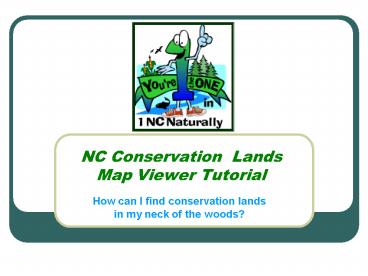NC Conservation Lands Map Viewer Tutorial - PowerPoint PPT Presentation
1 / 8
Title:
NC Conservation Lands Map Viewer Tutorial
Description:
The red box around a tool icon indicates this is the 'Active Tool'. Whenever you click with the mouse on top of the map window, this will execute ... – PowerPoint PPT presentation
Number of Views:53
Avg rating:3.0/5.0
Title: NC Conservation Lands Map Viewer Tutorial
1
NC Conservation Lands Map Viewer Tutorial
- How can I find conservation lands in my neck of
the woods?
2
Main Map Viewer Interface
3
Tools for controlling the Map Viewer (part 1)
Query the "Active" Map Layer
Zoom to the entire State
Go Back to the Previous Map View
Identify a map element in the "Active" Map Layer
Zoom Out
Zoom to the Selected Map Layer
Zoom In
Pan (slide) the Map View in a different direction
The red box around a tool icon indicates this is
the Active Tool. Whenever you click with the
mouse on top of the map window, this will execute
the action of that too. By Default, the Zoom In
Tool will be Active. Once you switch to another
Tool, it will remain active until you choose
another one. If you click on the map and
something other than what you expected happens,
check to make sure the Tool you wanted to use is
the Active one.
4
Tools for controlling the Map Viewer (part 2)
Select features in the "Active" Layer by drawing
a rectangle around them
Unselect selected features in the Active Layer,
or clear the distance totals in the measure tool.
Buffer the selected features in the "Active" Map
Layer
Change Measurement Readout Units (Ft. Mi.)
Select features in the "Active" Layer by drawing
a circle around them
Measure a distance on the Map View
Print a Map
Find a key word in the Active Map Layer
Online Tool Reference
5
How do the Map Layers work?
Top of the Layer List
Bottom of the Layer List
The map layer list is in a scrolling frame. You
wont be able to see all of the layers at once
there are too many. Use the scrollbar on the
right side of the layer list to slide up and down
the list. The layers are divided up in to major
categories, such as Transportation, Conservation,
Habitats, etc. Each folder icon next to the
category indicates that one or more map layers
are available in that major category.
6
What do all the checkboxes and radio buttons next
to layers mean?
At the bottom of the layer list, there is a short
layer icon help section if you need to refresh
your memory. Just scroll all the to the end of
the frame.
In this example, all of the layers in the
Conservation group are turned on because the
visible checkbox next to the group name is
checked. However, only the Managed Conservation
Land layer will show up in the map viewer. The
other 3 conservation layers are only visible at
higher or lower map scales. You will have to
either zoom in or zoom out before they will
appear on the map display.
7
What does the Active layer mean?
If the radio button directly to the left of the
layer name is selected, it indicates that layer
is currently the Active layer. Some of the map
tools only work on the Active layer. They are
the Identify, Query, Find, Buffer,
Select by Rectangle, Select by Circle, and
Clear tools.
As an example, if you the Identify tool is the
active tool and use it to click on a map element,
it will only list the information about that map
element if it is part of the Active layer. If
Managed Conservation Lands is the Active Layer
and you click on a city boundary or a street, the
Identify tool wont give you any information
about those items. You would need to make either
the City or one of the Roads layers active before
you could identify one of their elements.
8
What else do I need to know?
- When you use a tool to generate a new map display
or list information about a map element, it takes
a moment for the mapserver to create that
information and send it back to your web browser.
Youll see a Retrieving Map icon while the
browser is waiting for the response from the
mapserver. You should not keep clicking on
anything else until the mapserver responds to
your last request. If you do keep clicking, it
will very likely confuse the application and you
will get errors. The best way to recover from
this is to do a Control F5 and this will
reset the map application the browser and zoom
you back out to a view of the entire state. - Never use the Back button on the browser to try
to get back to your previous map view. You have
to use the Zoom to Last Extent tool (the black
left arrow) to do that. - If you ever get one of the occasional application
errors, you can also do a Control F5 to
recover and start over.



























![Eleanor McGregor [Director: Conservation] PowerPoint PPT Presentation](https://s3.amazonaws.com/images.powershow.com/8026054.th0.jpg?_=20160801045)



